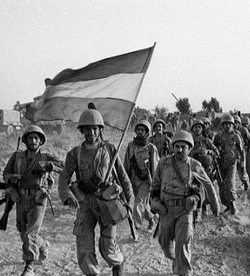Union of Khazestan and Pardaran
Union of Khazestan and Pardaran | |||||||||||
|---|---|---|---|---|---|---|---|---|---|---|---|
| 1952-1980 | |||||||||||
 The Union of Khazestan and Pardaran in 1963 | |||||||||||
| Capital and largest city | Zahedan | ||||||||||
| Official languages | Badawiyan Pasdani | ||||||||||
| Recognised regional languages | Kexri | ||||||||||
| Government | Single party state administered by a military junta | ||||||||||
| Supreme Leader | |||||||||||
• 1952-1953 | Hossein Khalatbari | ||||||||||
• 1952-1972 | Ali Sayyad Gharazi | ||||||||||
• 1972-1976 | Abdullah al-Atassi | ||||||||||
• 1976-1980 | Javad Jahandar | ||||||||||
| First Minister | |||||||||||
• 1952-1953 | Yadollah Shariatzadeh | ||||||||||
• 1953-1964 | Habibollah Mousavi | ||||||||||
• 1964-1972 | Abdullah al-Atassi | ||||||||||
• 1972-1980 | Majjid Ilkhanizada | ||||||||||
| Legislature | Central Command Council | ||||||||||
| History | |||||||||||
| 10 December 1952 | |||||||||||
| 11 December 1952 | |||||||||||
| 5 May 1953 | |||||||||||
| 17 September 1963 | |||||||||||
| 22 August 1974 | |||||||||||
| 18 May 1975-30 October 1979 | |||||||||||
| 11 January 1980 | |||||||||||
| Population | |||||||||||
• 1975 census | 98,111,984 | ||||||||||
| Currency | Toman | ||||||||||
| |||||||||||
The Union of Khazestan and Pardaran, UKP was a sovereign state in northern Coius from 1952 to 1980. It was initially a political union between Khazestan and Pardaran, construction on the basis Sattarism and Pan-Zorasanism. Between 1952 and 1980, it would expand to include the states of Ninevah (the Kexri Republic, prior to unification), Riyadha and finally Irvadistan, when the UKP became the Union of Zorasani Irfanic Republics in 1980.
Formed in wake of the Pardarian Civil War and the Khazi Revolution, the UKP rapidly grew in economic output, with the consolidation of a united petrochemical industry. Successive governments would focus on modernising industry, while using economic growth to also sustain a significant military force. Major infrastructure projects and improvements to healthcare, education and living standards saw its population grow from 68 million in 1952 to 98 million by 1975 (the annexations of Riyadha and Ninevah are included). For 19-years it was dominated by Ali Sayyad Gharazi, who become the public face of Pan-Zorasanism and a popular figure among some in the developing world. Throughout its 28-year history, the UKP was the main driving force behind Zorasani unification, engaging in numerous wars of unification against its Badawiyan neighbours, which it considered to be part of Zorasan. Abosorbing the Kexri Republic in 1963, North Khazestan in 1966, Riyadha in 1974 and finally, Irvadistan in 1980. The UKP was governed under a single-party state, led by the Revolutionary Masses Party, yet subordinate to a military junta in the form of the Central Command Council. While the UKP was defined by its pursuit of Zorasani unification, it was a notable force in the Coian anti-imperialist and anti-colonialist struggle.
In wake of Irvadistan's annexation in 1980, the UKP transitioned into the Union of Zorasani Irfanic Republics, establishing a federal union where its constituent parts were granted some degree of autonomy under the same single-party military dictatorship until 1985, when a limited form of popular democracy was introduced. The transition maintained the UKP's policy of equality between the Pardarian and Badawiyan peoples, while also eventually expanding it to include all ethnic groups within the federation.


